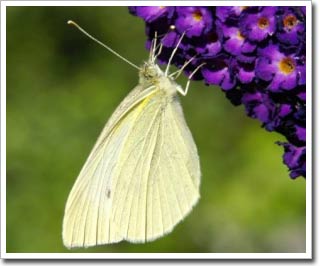Color butterfly wings structure
Nowhere in nature is there a lot of colors like the wings of butterflies, but scientists still face many obstacles in understanding how to create these colors. Marco Giraldo explored the structure of the wings of white-winged butterflies and a number of other species. Besides, he also investigated why European white-winged butterflies were more rejected than Japanese ones.
Giraldo will receive a doctorate in philosophy from Groningen University on January 25, 2008.
Colors on butterfly wings are used as an advertising message. The patterns on them help them recognize the distant homosexual and also to distinguish males and females, not necessarily to find couples. The wing surface is made up of a huge amount of colored dots (called scales) of size 50 x 250 micrometers per point (1 micrometer equals 1/15 millimeter).
However, scientists still do not fully understand how the colors on butterfly wings are formed. They only know that they are made in two different ways: by pigment and by nanostructures on scales to ensure the distribution of light in special ways to create beautiful colors. These colors are also known as structural colors, which can be clearly seen in morpho butterflies in the South African rainforest.
White butterfly wings
Marco Giraldo explored the structure and pigmentation of white-winged butterfly wings and a number of other species along the Pieridae family. He chose this species because they have relatively simple colors.

White-winged butterfly.Although only a very simple color, this butterfly is also affected by nanostructure characteristics.
By comparing the proportions of different colors under an electron microscope, he found the formations that produce colors in white-winged butterflies. Giraldo was the first to demonstrate the colors in these butterflies influenced by the nanostructural characteristics.
Scales structure
Although the spatial structure of color scales depends on individual butterfly species, they all have some common characteristics: A color scale consists of two layers connected by a cylinder. The bottom surface is quite smooth and unstructured. But the upper surface is made up of a lot of parallel, stretched strips that are about 1 to 2 micrometers apart. Colors are defined by the dispersion of light based on the scales structure and by the absorption of light by the presence of pigments. For example, the pigmentation of white-winged butterflies absorbs ultraviolet light and sulfur blue light. At the same time, these two lights radiate yellow or white in turn.
Effective
Giraldo is also the discovery of white butterflies created in an amazingly effective way. Both the upper and lower sides of the wings consist of two layers of overlapping scales that reflect light. The more layers of scales reflect the better the light. This reflection of light is very important because butterflies hope to see. Two layers of scales form an optical structure: if there are two layers, the reflectivity is increased, but the wings will become too heavy for the butterfly's body.
Japanese male butterflies
Giraldo discovered why Japanese male white butterfly butterflies were better able to identify females than European males of the same species. That's because the wings of different Japanese white butterfly butterflies are quite delicate between males and females, unlike their European relatives. Scales on the wings of Japanese females lack specific pigments that absorb UV rays, while Japanese males have these pigments. European white butterfly butterflies, whether male or female, contain pigment that absorbs UV light. That's why the male Japanese butterfly (able to see UV rays) distinguishes males and females.
Color industry
New methods of coloring can be developed by knowledge drawn from Giraldo's research. We can also apply the observed nanostructures on butterfly wings to create impressive optical effects in paints, varnishes, cosmetics, packaging materials or clothing. The idea of industry following the study of butterfly wings is indeed an interesting thing.
- The prospect of color changes like butterfly wings
- This butterfly with transparent wings will one day save our eyes
- Do you know where the butterfly's ear is?
- New anti-fake material from butterfly wings
- Fragile like butterfly wings, what will their fate be when the rain comes?
- Techniques for growing butterfly wings in the garden
- Admire the beautiful, exotic butterflies in Vietnam
- Discovered genes controlling colors and patterns on butterfly wings
- Discovering extremely rare butterflies
- Science has a new butterfly
- Breakthrough technology 'filter the light' inspired by the butterfly wings
- Butterflies disguising themselves as tigers threaten enemies terribly
 Why do potatoes have eyes?
Why do potatoes have eyes? 'Tragedy' the world's largest carnivorous life: Death becomes ... public toilet
'Tragedy' the world's largest carnivorous life: Death becomes ... public toilet Tomatoes were once considered 'poisonous' for 200 years
Tomatoes were once considered 'poisonous' for 200 years Detecting microscopic parasites on human face
Detecting microscopic parasites on human face